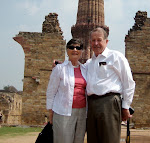







What a wonderful new country we discovered in Bhutan! It's beautiful, has nice people, is extremely interesting, and not too hard to travel in. The roads are hard; according to one source there is a curve every 9 seconds (some times it seemed more often to us), and the roads are narrow. On the other hand, the population of the country is only about 600,000 so there are not tremendous numbers of vehicles. Our accommodations were very pleasant, in one hotel we found a hot water bottle in our bed as we retired for the night! Cold sheets are not my favorite, so that was very nice. Our days were warm enough to be pleasant, our nights and mornings were frosty, but we had enough clothing to layer until it warmed up. We spent the week with our dear friends of many years, Bob and Jelean Montgomery. They are on an extended journey through Southeast Asia, and we felt lucky to join them for a few days in Bhutan.
Our one sadness was that we didn't see the Himalayas as our days where we might have viewed them the visibility that was limited with low cloud cover. The one beautiful mountain sight we had was of Mount Jomolhari, which at 24,000 feet is a magnificent backdrop for the Drukyel Dzong. This mountain, which marks the frontier with Tibet, is sacred, as are all the mountains in Bhutan, and it is the dwelling place of the Goddess Jomo. It was first climbed in 1937, but the expedition made it clear that is had not actually set foot on the summit. Jomolhari has never been climbed since and it is now a 'protected peak.' According to our guide book, Drukyel Dzong (a dzong being a fortress) was built on a rocky spur that blocks the Paro valley and protected it from invasions from the north. The Dzong was built in 1647. In 1951 a butter lamp fell over and started a dramatic fire, and only the walls remain. There was a picture published in the National Geographic magazine in 1914 as it appeared before the 1951 fire. In some ways, it was more fascinating in its burned out state, where we could better understand the layout of a Dzong. The butter lamps have caused some terrible fires in the places of worships in Bhutan--Dzongs, temples and monasteries have all suffered some fire destruction. They no longer use the butter lamps for their main source of light. We did visit many beautiful dzongs, temples and monasteries that were still intact--most built from the 11th to the 17th centuries.
One of the most dramatic of these which did burn down but has since been rebuilt, is the Taktshang Lhakhang complex which sits at almost 10,000 feet above sea level. In April 1998 Taktshang burned down, but the government rebuilt it and it was consecrated at the end of March 2005. The buildings cling to the black rock, overhanging the valley below by 2600+ feet. The location is very impressive, and was not easily reached by us, as we had arrived only the day before from sea level. It is one of the most venerated places of pilgrimage in the Himalayan world, and we felt very happy and proud of ourselves that we were able to accomplish this amazing climb and see and feel the sacredness the Bhuddhist people celebrate.
Bhutan has just celebrated 100 years of a continuous monarchy--5 kings, father to son. The 5th king was crowned in 2006. He turned 29 while we were there and we participated in 3 days of celebration for his birthday. We enjoyed a wonderful activity of dancing and speeches in Paro in his honor. He is a very handsome young man, single, looking for his bride to be. There are no arranged marriages in Bhutan, so the queen will be chosen by the new young king. Bhutan is the newest democracy in the world--6 months old. They are slowing setting up the parliament and all the ministers, with the king actively taking a part in it all. There is pride in their monarchy, but also in this new democracy they are working on.
Buddhism is the religion of the country. Their worship is part of their daily lives, and tradition in their dress and their culture is very evident. The monks (of which there are about 6000 at present) are taken care of by the state. They live in dzongs and monasteries and wear the characteristic dark red robe. They take care of all the religious sites, including the temples. A child will usually begin their training to become a monk at about 6 or 7 years if age. Buddhism first came to Bhutan in about the 8th century, but really took hold in the 11th and 12th centuries. It seems to be a gentle religion which affects the people of the country--speech, actions, etc.
Bhutan separates China from India--two powerful neighbors, and the Bhutanese are proud of the fact that they have never been conquered by anyone.
One thing we loved seeing was the countries national animal--the Takin. It is part goat, part cow, and has a wonderful story that goes with it about how this came about! Ask us about it sometime.
There is so much to tell, but hopefully a few pictures will explain more. We loved our journey and would recommend it as a travel destination.

No comments:
Post a Comment